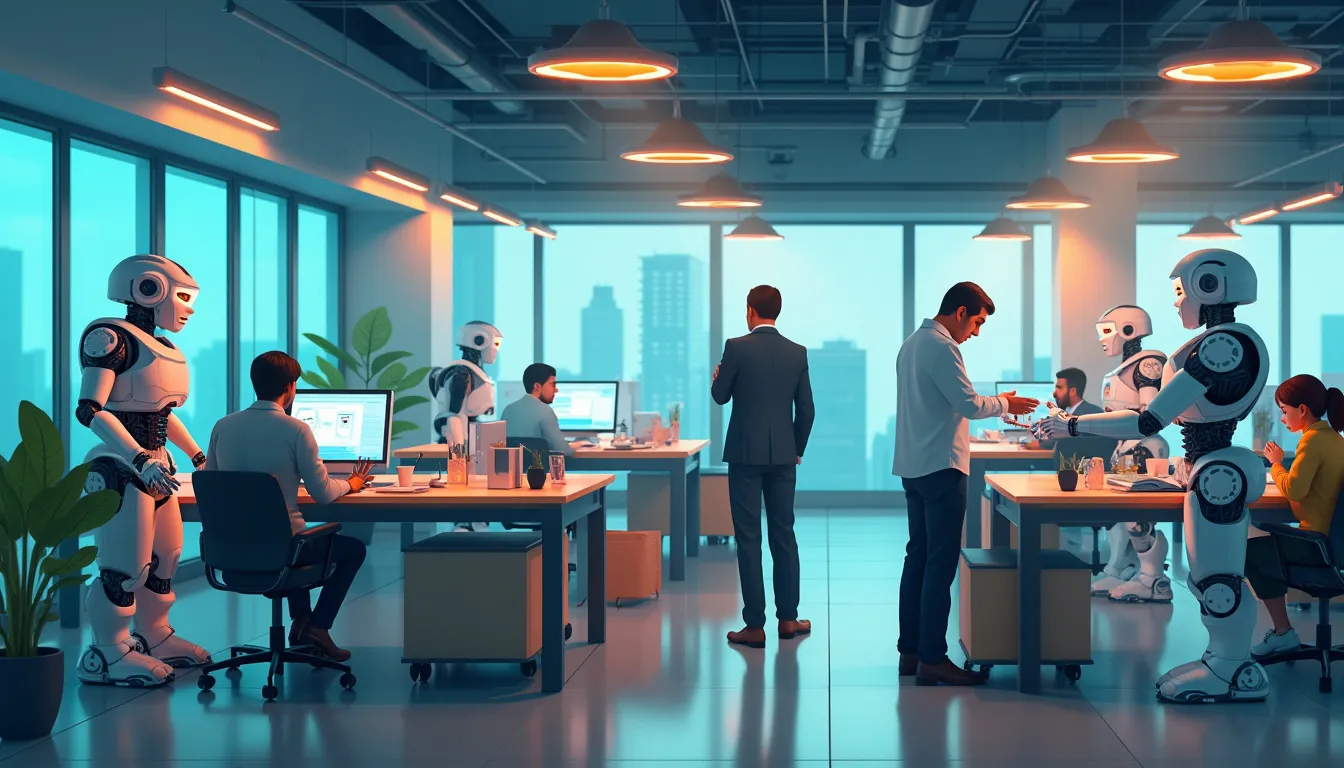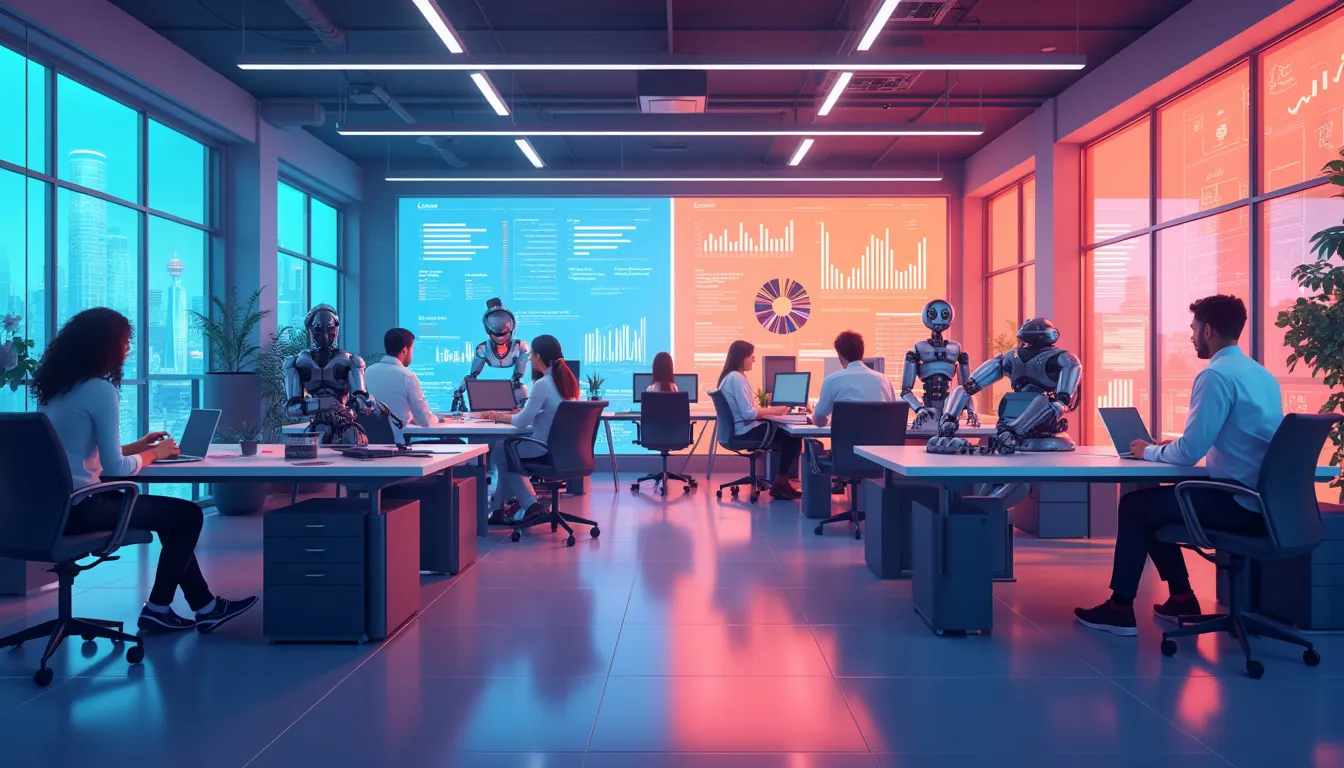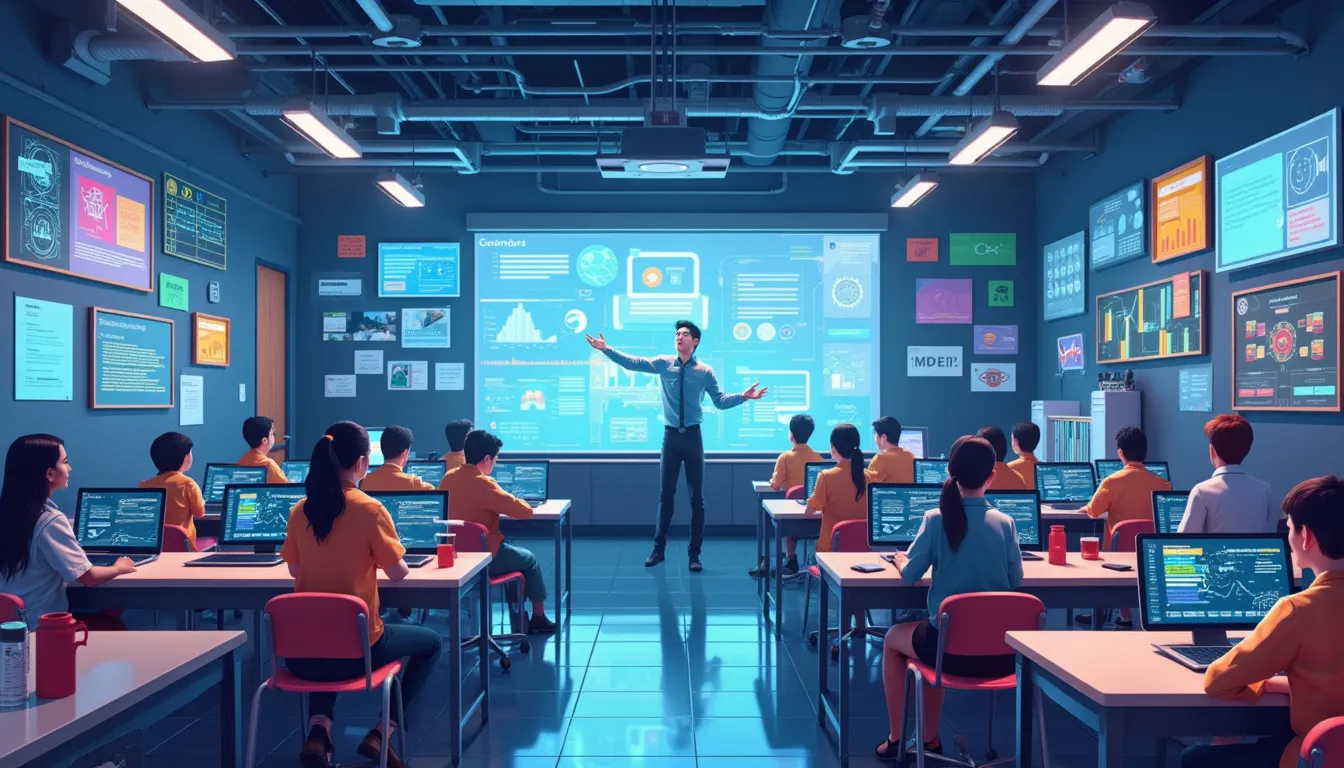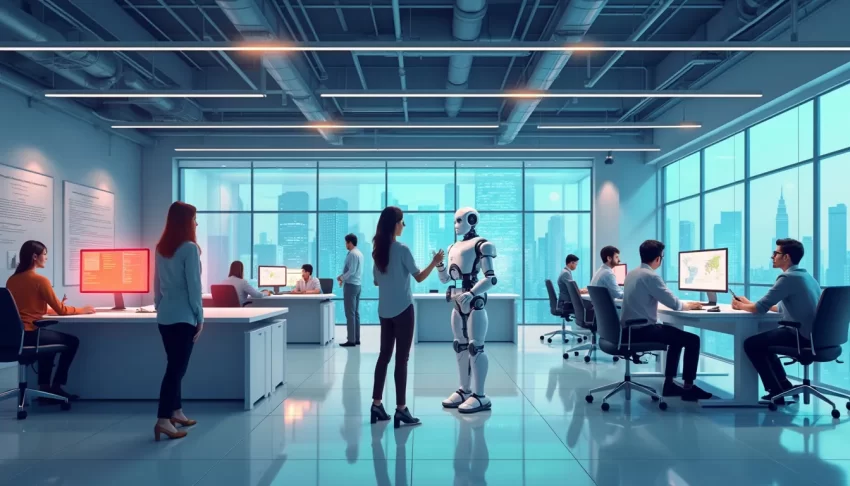Imagine walking into your office and being greeted by an AI assistant that has already streamlined your daily tasks, or perhaps, your role in the company has shifted entirely due to the emergence of new AI-driven opportunities. This is not a scene from a science fiction movie; it’s the reality we are steadily moving towards. Welcome to our exploration of how AI is shaping the future of work—a phenomenon that is revolutionizing industries and redefining traditional job roles at an unprecedented pace.
Artificial intelligence, or AI, refers to the simulation of human intelligence in machines that are programmed to think and learn. AI isn’t just a distant concept reserved for tech enthusiasts; it’s a transformative force that is actively altering our professional landscapes. Understanding AI’s profound impact on the job market is critical, not only for staying relevant but also for leveraging these advancements to create more efficient, innovative workplaces. AI’s role in transforming work environments is multifaceted, influencing everything from automation to enhanced decision-making processes.
As an expert in both safety and artificial intelligence, I’ve witnessed firsthand how AI-powered automation is revolutionizing various industries, making once-tedious tasks more efficient and allowing humans to focus on more complex, creative endeavors. This technology is not just about job displacement; it’s about job evolution. Sure, some traditional roles may become obsolete, but AI is also birthing new roles that require a blend of human intuition and technological proficiency—a balance that promises more innovation than ever before. And let’s face it, wouldn’t we all trade a few mundane tasks for the chance to tackle more exciting challenges?
However, with these advancements come new responsibilities. Maintaining workplace efficiency with AI goes beyond merely integrating new tools. It requires a commitment to continuous skills development and a willingness to evolve alongside technology. Companies that have successfully integrated AI demonstrate this, showing that the ROI on investing in training and education far outweighs the initial costs.
As we prepare for this AI-driven future, it’s essential to equip ourselves with the necessary skills and strategies. Businesses and employees alike need to embrace lifelong learning and adapt to rapid technological changes. Understanding which skills are becoming more valuable can help guide career development and organizational growth. Just as important is fostering an environment that supports adaptation and continuous learning—key elements for thriving in this new era.
So, whether you’re an industry veteran or just starting out, now is the time to explore, adapt, and innovate. Through strategic planning and a commitment to growth, we can not only navigate but also shape the future of work in an AI-driven world. Ready to dive in? Let’s embark on this transformative journey together.
Introduction to AI and the Future of Work
Brief Overview of Artificial Intelligence (AI)
Artificial Intelligence, or AI, represents a branch of computer science where machines are trained to perform tasks that traditionally require human intelligence. These tasks range from simple data processing to complex problem-solving and decision-making. AI systems utilize algorithms and vast datasets to learn from patterns, enabling them to predict outcomes and adapt their actions accordingly. As a result, AI technology is rapidly integrating into various facets of daily life, changing everything from how we shop to how we work.
Importance of Understanding AI’s Impact on the Job Market
The advent of AI is not just a technological breakthrough but a societal shift. Its implications on the job market cannot be overstated. AI is reshaping industries, modifying job roles, and introducing new career paths that didn’t exist even a decade ago. For instance, roles in data science, machine learning engineering, and AI ethics have grown exponentially in demand. On the flip side, traditional roles that are routine-based or repetitive in nature face the risk of automation. Thus, understanding AI’s impact is crucial for both employees and employers to navigate the evolving landscape strategically.
Role of AI in Transforming Work Environments
In modern work environments, AI acts as a catalyst for transformation. Organizations are harnessing AI-driven tools to enhance efficiency, accuracy, and decision-making processes. Consider the case of customer service: AI-powered chatbots now handle initial queries, allowing human agents to focus on more complex issues. Similarly, predictive analytics tools enable businesses to forecast market trends with greater precision, leading to informed decision-making. These transformations lead to more streamlined operations, higher productivity, and ultimately, a more dynamic and competitive marketplace.
Maintaining a balance between technological progress and human adaptability is essential. For instance, my journey managing ADHD and OCD while navigating a career in safety and AI has highlighted the importance of resilience and continuous learning. Just as AI systems require regular updates and maintenance to stay relevant, individuals must also stay informed and adaptable to thrive amidst these changes. The focus should not merely be on preserving current job functions but on evolving along with technological advancements.

AI-Powered Automation and Job Evolution
As artificial intelligence (AI) continues to evolve, its impact on the workplace becomes increasingly profound. One of the most significant ways AI is shaping the future of work is through automation. Across various industries, AI-powered automation is streamlining processes, enhancing productivity, and transforming job roles in ways that would have been unimaginable a decade ago.
Examples of Automation in Different Industries
Consider the manufacturing sector, which has long been a hotbed for automation. Robotics and AI systems are now conducting precision tasks more efficiently and accurately than human workers could. For instance, BMW’s production line employs AI to ensure impeccable precision in assembling complex machinery. This not only increases output but also reduces errors, ensuring higher quality and reliability.
In the healthcare industry, AI is revolutionizing everything from diagnostics to patient care. IBM’s Watson, for example, analyzes vast amounts of medical data to assist doctors in diagnosing illnesses with unprecedented accuracy. This technology allows for earlier and more precise interventions, ultimately saving lives. It’s not just about robots assembling cars anymore; it’s about intelligent systems reshaping how we approach the most critical aspects of human existence.
How AI is Changing Traditional Job Roles and Creating New Opportunities
The transformation doesn’t stop at automation. AI is significantly altering traditional job roles and creating new opportunities. Take the role of a financial analyst. Historically, this position required sifting through reams of data to make informed predictions about market trends. Now, AI algorithms can analyze data in real time and generate insights faster and more accurately than any human could manage. This shift allows financial analysts to focus more on strategic decision-making and less on menial data management tasks.
Meanwhile, entirely new job roles are emerging. ‘AI Trainers’ are individuals who teach AI systems to interpret specific data sets correctly, ensuring the technology adapts to various tasks efficiently. Cybersecurity experts, too, must now understand how to protect AI systems from evolving threats, blending traditional IT skills with a deep understanding of AI mechanisms. These new roles not only provide fresh career opportunities but also necessitate a continuous evolution of skills, which brings its own set of challenges and rewards.
On a personal note, managing ADHD and OCD has given me a unique perspective on adaptability and efficiency. The constant need to streamline tasks and stay organized mirrors the very principles behind AI automation. This personal journey has taught me that, just like managing a condition or losing weight, the key to thriving in an AI-driven world lies in continuous, adaptive learning and resilience.
The Balance Between Job Displacement and Job Creation
It’s undeniable that AI and automation can lead to job displacement. According to a study by the McKinsey Global Institute, up to 800 million global workers could be replaced by automated systems by 2030. However, history shows that technological advancements also lead to the creation of new types of jobs. The advent of computers in the late 20th century rendered some jobs obsolete but also gave rise to the entire field of information technology.
This duality of displacement and creation is striking in modern retail. While cashier roles may diminish due to self-checkout kiosks and automated systems, the rise of e-commerce has generated a significant number of logistics and supply chain management jobs. Amazon’s vast network employs thousands in roles ranging from warehouse management to drone operation specialists, jobs that were unheard of just a few years ago. The key is ensuring workers impacted by automation are re-skilled to take on these new opportunities.
In essence, AI and the future of work is about finding a balance. Policymakers, educational institutions, and corporations must collaborate to create pathways for workers to transition into new roles. This means investing in education and training programs that equip the workforce with the skills required for tomorrow’s jobs. As someone who has navigated significant personal challenges, I can attest that support systems are vital. Just as community and professional support have been crucial in managing my ADHD and OCD, societal support structures are essential for guiding workers through this transition.
Ultimately, while AI-powered automation presents challenges, it also opens the door to a world of new job possibilities. By focusing on re-skilling and up-skilling the current workforce, we can ensure that the evolution of work driven by AI leads to a more productive and inclusive future.

Enhancing Workplace Efficiency with AI
AI and the future of work are intrinsically linked, with Artificial Intelligence providing a suite of tools that significantly boost productivity and operational efficiency. Strategies for leveraging AI in the workplace range from optimizing everyday tasks to transforming entire business models. Let’s explore how AI tools are driving workplace efficiency and examine some real-world cases where companies have reaped the rewards of implementing AI-based solutions.
AI Tools That Improve Productivity and Efficiency
AI tools have become indispensable in contemporary work environments, providing solutions that streamline processes and reduce the burden of repetitive tasks. From machine learning algorithms analyzing vast datasets to AI-driven chatbots handling customer service inquiries, AI tools help to heighten productivity and operational efficiency.
Take, for instance, the use of Natural Language Processing (NLP) in managing internal communication. Tools like Grammarly have harnessed NLP to not only correct grammar but also provide suggestions for better clarity and tone, ensuring that communications are both professional and effective. This enhances productivity by minimizing misunderstandings and expediting the writing process.
Moreover, Predictive Analytics plays a critical role in decision-making. Consider supply chain management, where predictive analytics can forecast demand trends, enabling companies to optimize inventory levels and reduce holding costs. This not only cuts down on waste but also aligns production schedules more closely with market demand, fostering a more efficient operational environment.
Case Studies of Companies Successfully Integrating AI
Several companies have successfully integrated AI into their operations, leading to significant gains in efficiency and productivity. One notable example is the e-commerce giant Amazon. Amazon uses AI to enhance its supply chain management and logistics operations. With AI-driven algorithms, the company can predict customer purchases and align its inventory accordingly, ensuring timely delivery while reducing costs.
Another illustrative example is General Electric (GE). GE has embraced AI, particularly in its manufacturing processes. By utilizing AI-driven predictive maintenance, GE can forecast equipment failures before they occur, allowing for preventative maintenance that reduces downtime and extends the lifespan of machinery. This proactive approach not only enhances productivity but also minimizes operational disruptions and expenses.
AI is not exclusive to large corporations. Smaller companies and startups also benefit from these technologies. For instance, the online retailer Stitch Fix employs AI to personalize customer experiences. With machine learning algorithms analyzing customer preferences and feedback, Stitch Fix can offer more personalized product recommendations, improving customer satisfaction and loyalty, while also streamlining their inventory management.
The Importance of Continuous Skills Development for Employees
As AI technologies continue to evolve, it’s essential for employees to engage in continuous skills development. This ensures they remain competitive in an ever-changing job market where proficiency with AI tools can significantly enhance their value.
First, employees need to develop a robust understanding of AI fundamentals. This can include basic programming skills, data analysis, and familiarity with machine learning algorithms. Online platforms such as Coursera and Udacity offer courses and certifications that can help employees acquire these essential skills.
Moreover, businesses must foster a culture of lifelong learning. This involves providing ongoing training opportunities and encouraging employees to adopt a growth mindset. Offering incentives for skills acquisition and creating pathways for career advancement can motivate employees to continuously improve and adapt to new technologies.
One way to achieve this is through on-the-job training programs. Companies can organize workshops, seminars, and practical sessions where employees can apply new skills in a real-world context. For example, IBM offers its employees comprehensive training programs focused on AI and data science, ensuring that their workforce is well-prepared to leverage these technologies effectively.
Additionally, companies can adopt collaborative learning platforms. Tools like Slack and Microsoft Teams facilitate knowledge sharing and teamwork, allowing employees to learn from each other and collectively solve problems. Creating internal forums and discussion groups can also promote an environment where information flows freely, enhancing collective intelligence and innovation.
Lastly, it’s essential to recognize the personal challenges that come with adapting to new technologies. Managing conditions such as ADHD, OCD, and weight loss can be demanding, but they’re not insurmountable obstacles. Employees dealing with these challenges can benefit from AI-driven tools designed to improve focus and mental well-being. For example, apps like Headspace for mindfulness and Todoist for task management can help individuals manage their symptoms more effectively, thereby boosting their productivity and overall job satisfaction.
In conclusion, AI is a powerful catalyst for workplace efficiency. By leveraging AI tools, companies can streamline their operations, and employees can develop essential skills to thrive in the AI-driven job market. Continuous learning and adaptation are key to remaining competitive as AI continues to shape the future of work.

Preparing for the Future: Skills and Strategies
As AI continues to redefine industries, it’s imperative for both businesses and employees to proactively prepare for the future of work. Understanding the essential skills required for an AI-driven job market, and devising effective strategies for adaptation, will be key in navigating this transformative landscape. The significance of lifelong learning and education cannot be overstated in ensuring a smooth transition to this new era.
Essential Skills for the AI-Driven Job Market
In the evolving world driven by AI, certain skill sets are becoming increasingly valuable. For instance, technical skills such as programming, data analysis, and machine learning are in high demand. Workers proficient in these areas find themselves particularly well-positioned in the job market. Additionally, soft skills like critical thinking, creativity, and emotional intelligence are equally crucial. These skills enable employees to complement AI technology effectively and drive innovation within their organizations.
Take the example of Sarah, a marketing professional who saw the writing on the wall early. Recognizing the limitations of traditional marketing strategies, she upskilled by taking online courses in data science and machine learning. Her ability to analyze large datasets and predict consumer behavior transformed her into a valuable asset for her company, leading to increased efficiency and targeted marketing campaigns. Sarah’s story exemplifies how a blend of technical and soft skills can future-proof one’s career in an AI-centric world.
Strategies for Businesses and Employees to Adapt to AI Advancements
Adapting to AI advancements requires a strategic approach from both businesses and employees. For businesses, investing in AI education and training programs is crucial. Companies that foster a culture of continuous learning encourage their workforce to acquire new skills and stay relevant. Additionally, businesses should actively promote interdisciplinary collaboration, as this diverse approach can drive groundbreaking innovations.
Employees, on the other hand, must consciously commit to personal development. This can be achieved through pursuing further education, attending workshops, or participating in online courses focused on AI and related technologies. Building a robust professional network is equally important, as it provides insights into emerging trends and opportunities. Consider John, an IT specialist, who enrolled in a company-sponsored AI training program. His willingness to adapt and learn not only enhanced his own career prospects but also contributed to his company’s successful AI implementation projects, setting a benchmark for peers.
The Significance of Lifelong Learning and Education in the AI Era
The rapid advancements in AI technology underscore the importance of lifelong learning and education. The job market is becoming increasingly dynamic; roles are evolving, and new positions are emerging at a fast pace. Remaining stagnant is no longer an option. Embracing a mindset of lifelong learning equips individuals with the ability to continuously adapt and grow alongside technological advancements.
The personal journey of David, a finance professional managing ADHD and OCD, illustrates this point vividly. Despite the challenges, David’s commitment to his intellectual growth and his adaptability were pivotal in his career progression. By consistently upskilling and leveraging AI tools to manage his workload more effectively, David not only overcame his personal hurdles but also excelled in his profession, demonstrating the transformative power of education and resilience.
Moreover, educational institutions and corporate training programs must evolve to provide relevant and up-to-date content. Forming partnerships with tech companies can help in delivering practical, hands-on experience with AI technologies. Organizations like Coursera, edX, and LinkedIn Learning offer extensive resources that can be tapped into for continuous learning.
On a broader scale, society as a whole must prioritize educational reform that incorporates AI literacy. Early exposure to STEM (Science, Technology, Engineering, and Mathematics) subjects can foster a deeper understanding of AI and its applications. Policy-makers, educational institutions, and industry leaders need to collaborate to create a workforce that’s not only skilled but also adaptable to the changes brought about by AI.
Embracing lifelong learning involves commitment and consistency, elements well-demonstrated by individuals and companies leading in their respective industries. By giving emphasis to regular learning and skill enhancement, we can ensure that the transition to an AI-driven future is not only smooth but also filled with opportunities for growth and innovation.
In conclusion, preparing for the future work environment shaped by AI necessitates a proactive approach in skill acquisition and strategic adaptability. The integration of technical and soft skills, enhanced by a lifelong learning mindset, is key to remaining relevant and excelling in the evolving job market. By adopting these strategies, businesses and employees alike can turn the challenges posed by AI into unparalleled opportunities for development and success.
As we stand at the cusp of a new era defined by artificial intelligence, understanding and embracing its impact on the future of work is more crucial than ever. AI is not merely a buzzword; it’s the transformative force behind the changing landscapes of industries and job markets worldwide. From automating mundane tasks to creating entirely new roles, AI is revolutionizing how we perceive work itself.
The examples of AI-powered automation we’ve explored illustrate how different sectors are leveraging technology to enhance productivity and efficiency. While there are legitimate concerns about job displacement, it’s equally important to recognize the new opportunities AI is creating. The balance between these two forces will shape the future job landscape, demanding adaptability and foresight from both businesses and employees.
For workplaces, the integration of AI tools offers a pathway to unparalleled efficiency. Case studies have highlighted that when companies proactively integrate AI, they not only streamline operations but also position themselves as leaders in innovation. However, this transformation requires a commitment to continuous skills development. Employees must be equipped to navigate an AI-enhanced environment, making lifelong learning and upskilling vital components of this new paradigm.
Looking ahead, the emphasis on essential skills for the AI-driven job market cannot be overstated. Critical thinking, adaptability, and technological literacy will be the cornerstones of the future workforce. Businesses must foster a culture of learning and agility, ensuring their teams are well-prepared to harness the benefits of AI. Similarly, individuals should seize every opportunity to cultivate these skills, positioning themselves favorably in an evolving job market.
In navigating this brave new world, my experiences with ADHD, OCD, and weight loss have taught me that challenges can be a powerful catalyst for growth. The journey of managing these personal hurdles parallels the professional journey of adapting to AI: both require resilience, continuous learning, and an unwavering commitment to progress. By facing these challenges head-on, we empower ourselves and our organizations to not just survive, but thrive in the AI era.
As we conclude, I urge you to take action—whether you’re an employer or an employee. Invest in education, embrace customization and innovation, and remain agile. The future of work is not a distant horizon; it’s here, driven by the inexorable advance of AI. Let us be proactive architects of this future, shaping it with the knowledge, skills, and resilience necessary to turn challenges into opportunities.
Support Us: Check out our recommended products on Amazon.

